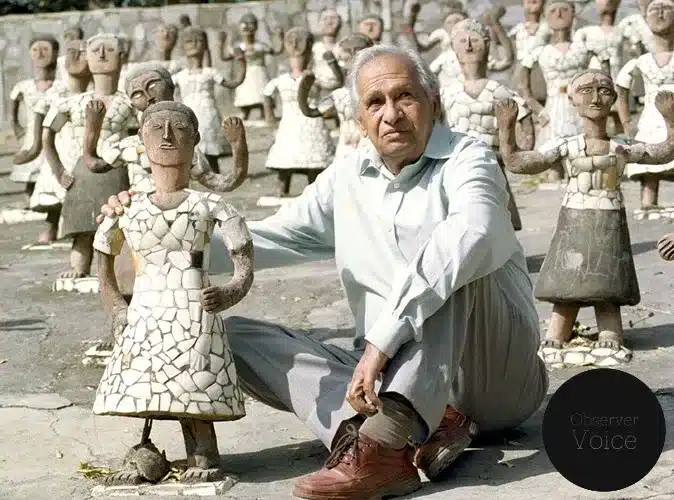Nek Chand (15 December 1924 – 12 June 2015), was a self-taught Indian artist. He is best known for building the Rock Garden of Chandigarh, an eighteen-acre sculpture garden in the city of Chandigarh, India.
Early Life
Nek Chand was born on 15 December 1924, in Pakistan. Chand lived with his uncle as an adolescent and went to high school. Upon graduation, he went back to his village and became a farmer.
During the partition of 1947, his family moved to Chandigarh. At the time, Le Corbusier, a Swiss/French architect, was reshaping the city into a modern utopia. In 1951, Chand was hired as a road inspector for the Public Works Department of the city, the first planned city in India.
Rock Garden
From 1958 on, Chand started collecting materials for a garden he wanted to build in a forest outside the city. Over the next 18 years, he biked around the city and countryside looking for rocks, stones, trash, and debris from the 20 or so small villages that were leveled. He started building the garden in 1965. Chand worked illegally because it was protected public land, designated as a no-building zone by the government.
After a government official discovered Chand’s garden in 1972, the government didn’t destroy it due to the public’s support – at that point the garden covered 12 acres (about 5 hectares). Government took over and Chand was hired to oversee the project and given 50 employees to help. Despite opening to the public in 1976, Chand and his staff continued to build and expand the rock garden to about 30 acres (12 hectares).
He used recycled materials to build up the mass of the sculpture, and then added a layer of burnished pure cement mixed with waste products like broken glass, bangles, crockery and iron-foundry slag. The figures were then decorated with shards of pottery, porcelain, glass, bottle caps, or anything else that had texture. They have stiff postures and masklike faces. Chand arranged the figures neatly in groups throughout the garden, making them look like frozen armies. Also in the garden are plazas, courtyards, archways, swings, a stone amphitheatre, and a large series of swings for visitors. There are waterfalls and flowing streams in the lush landscaping.
In 1986, the park was opened as a public space.
More than twelve million people visit the garden a year, making it the second most popular spot in India (after the Taj Mahal). Thousands of people visit the rock garden every day. It’s become one of India’s biggest tourist attractions.
Award
In 1985, he was awarded the Padma Shri award for distinguished service to the arts.
Death
He died on 12 June 2015, in Chandigarh, India.
Read More: 14 December: Remembering B. K. S. Iyengar on his Birth Anniversary
Read Also: 14 December: Remembering Raj Kapoor on his Birth Anniversary

